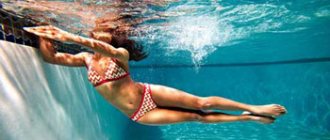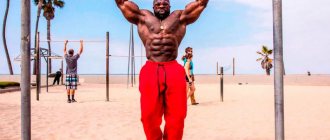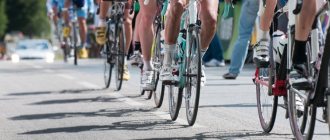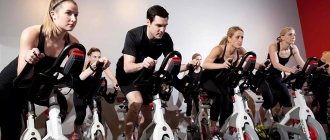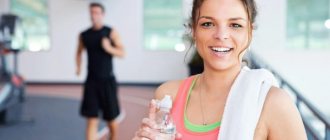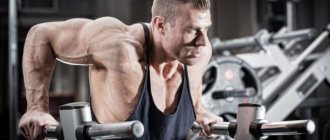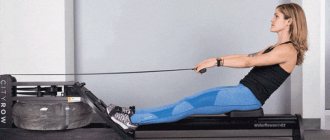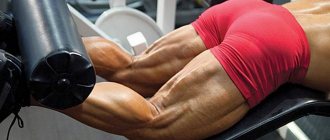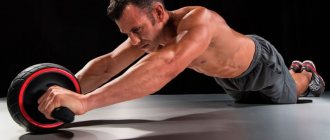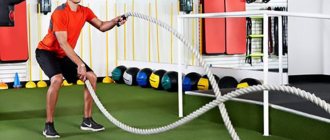Running is a truly unique sport, attractive for its accessibility and versatility. One of its advantages is that in the process of physical activity almost all the muscles of the body are involved, just some to a greater extent, others to a lesser extent. That is why most people only need running to maintain their figure and health. And thanks to its various techniques, you can give a targeted load to the desired muscle groups. Let's look at what muscles work when running.
What muscles work when running outdoors?
There is practically no difference from the work of skeletal muscles on a treadmill.
- Thigh muscles. On the front and partially on the lateral surface is the quadriceps muscle (quadriceps), one of the largest muscles of the human body. The four large bundles that make up the quadriceps are often divided into separate muscles: rectus, lateral, intermedius, and medial femoris. When running, they primarily work in the initial phase of the stride, responsible for lifting the hip and bringing the lower leg and foot forward.
- Hip flexors. This is, first of all, the biceps femoris muscle (femoral biceps), located behind the buttock to the knee bend. In its lower part is the hamstring tendon. The biceps of the thigh sweeps the heel back and is included in the movement in the last phase of the running step, when pushing off with the foot and after it.
- Buttock muscles . The gluteus maximus, gluteus medius and gluteus minimus muscles work actively both at the beginning of the movement, when we lift the leg, and during the push, and when sweeping the leg back. They relax only during the flight phase. In addition, these muscles are involved in core balance during running.
- Calf muscles The gastrocnemius and soleus muscles come into play when the foot is engaged, that is, from the moment of landing to the moment of push-off. Since these muscles are closely related to the extension of the foot, the main load falls on them at the moment of rolling and pushing off along the foot. This movement pumps up the calves, which is why they are well developed in professional runners.
- The tibialis anterior muscle is located on the front of the lower leg. It helps flex the foot, so it connects when pushing off. Helps stabilize the position of the legs.
- The peroneal muscles of the lower leg are located on its sides. You can feel them by twisting your foot left and right and bending it toward you in extreme positions. They also help the running function of the foot - rolling, pushing off. They also participate in stabilizing the foot and its correct pronation, that is, they help ensure that the feet do not turn outward, but are placed parallel.
Contraindications to jogging
Classes are not recommended if:
- A person has a cold, the cold has not been cured, or it is just beginning;
- Chronic diseases have worsened;
- There are musculoskeletal injuries, sprains, and bruises;
- Diagnosed with heart and vascular diseases;
- Malaise does not allow active movement
In the latter case, the training should be postponed. In all other cases, consultation with a doctor is required. There is no consensus regarding pregnant women. Western obstetricians and gynecologists allow their patients to jog if there are no health-threatening conditions. Domestic people advise to switch to walking.
Serious running requires normal nutrition. That is, a person must initially make a choice: if he runs to lose weight, he should forget about speed and limit himself to jogging several times a week and short distances. If the goal is to increase speed and run longer distances, following a calorie deficit diet is not rational. Then they eat according to need, providing a sufficient level of energy with the help of carbohydrates. Run regularly to reap the benefits of this activity.
Igor February 12, 2019
From the heel or from the toe: which muscles are strengthened while running?
The question of running technique is “heel or toe?” - an eternal topic for discussion. “There is no definite answer to this,” Ekaterina Demidova is convinced. “But when running, the load is distributed most optimally from the front and middle parts of the foot. In terms of muscle activation, the main difference will depend on the training style. Slow jogging requires the least engagement of the arm and leg muscles and is more like an elastic fascial recoil." Let us explain: fascia is the connective tissue membrane of muscles, which is also responsible for their extensibility. When running slowly, the inertia of movement plays a big role, and not the forceful push-off of the foot, and it is important that the muscles spring - and the fascia plays a great role in this.
“If we consider acceleration and “running” uphill,” continues Ekaterina, “then more muscle strength is required, since the runner has to work with the weight of his own body. This format is more like strength training.” In general, running is an aerobic form of exercise, so you shouldn’t expect much muscle hypertrophy.
Beginner runners often notice some increase in muscle fibers. But this is not muscle hypertrophy in its pure form, which involves cell growth. This is simply the filling of the muscles with blood, plus the appearance of lactic acid. Intense sprinting, unlike slow jogging, engages fast-twitch muscle fibers and specifically stimulates muscle cell hypertrophy. In any case, which skeletal muscles are used when running does not depend on the type of running: they all work the same, only with different intensities.
Increase in size or relief?
Running is a cardio workout. Muscle work when running consists of frequently repeated cyclic exercises. In this case, there is no resistance to the work of the muscular apparatus.
Muscles tense, lengthening when exercised. Tendons and ligaments store energy during landing.
As a result, breakdown products (lactic acid) accumulate. Microtears of the muscles provoke minimal swelling of the fibers. Blood flows stronger during exercise to supply muscles with oxygen, and after exercise to repair damage.
All this causes slight muscle hypertrophy. Therefore, at first it seems that muscle mass is building up.
In fact, the muscles working when running become more resilient, stronger, and more elastic. Strength and mass practically do not increase.
You will get a sculpted, toned body, lose extra pounds, improve your health, and become resilient.
What upper body muscles does running strengthen?
Almost all stabilizers. “The abs are involved here - the rectus abdominis, deep core muscles, serratus muscles, and arm muscles - biceps, triceps, deltoids,” says Ekaterina Demidova. “The load varies depending on the type of running workout.”
- Muscles of the upper shoulder girdle . The deltoids, biceps and triceps work in sync with the legs to set the pace. They are involved in stabilizing the core and helping the runner move forward rhythmically. The work of the arms is especially pronounced in sprinters, who even pump them separately.
- Muscles of the body (bark). Essentially these are the abdominal muscles, plus deep muscles responsible for stabilizing the spine and balance during movement. If the deep muscles mainly maintain balance, then the abdominal muscles are actively involved in raising the knee and hip. They are particularly stressed when running uphill.
Bottom line
As you may have noticed from this article, running uses a lot of muscles, and not all of them are in the legs. Running is a movement along a surface, during which the body also needs to maintain balance, saturate the lungs with oxygen, and create a driving force. I would like to draw your attention to the fact that if you do not perform additional training to develop auxiliary muscles, you risk injury. I myself am not a big fan of general physical training, because it’s so boring! However, a series of injuries in various areas of the body simply forced me to perform exercises on: back, knee, calves, adductors.
Good luck to all!
Is it possible to pump up your abs by jogging?
It will not be possible to greatly increase the volume of muscle mass in the abdominal area. But it is quite possible to burn fat, revealing muscle relief, tightening, drying and working out the “cubes”. Trail running is especially good at this. On dirt roads and trails, the abdominal muscles rely more on stabilization to maintain balance. Running in the hills will teach you to lift your legs higher up the hill, but in the forest you have to raise your feet so as not to trip over roots or bumps. Trail runners have very impressive abs without much additional exercise.
Is it worth additional training for running muscles?
It depends on what running goals you set for yourself. In general, the shorter the distance, the more important strength and speed-strength training is. Moreover, their task is not just to gain muscle mass, but to increase explosive speed and sharpness. In this mode, of course, some gain in muscle mass occurs, because sharpness without strength, and strength without volume, are unattainable. But the muscle mass of bodybuilders or weightlifters cannot be achieved by running, regardless of which muscles are pumped when running.
“Running in itself is an excellent workout,” says Ekaterina Demidova, “however, in order to improve your performance and the condition of the musculoskeletal system, additional functional training is necessary. By strengthening your muscle through strength training, you can produce more force when you accelerate or run uphill. Strengthening the stabilizer muscles will help protect yourself from injury, and training to improve mobility will give you a greater range of motion and speed up recovery processes.” There are also a huge number of special running exercises, primarily for the development and strengthening of the foot, which can be performed as a warm-up or as a separate workout.
Differences in training for men and women
There are no differences between training for men and women. Each person independently chooses a training program, intensity and duration, focusing on their own physical characteristics and health status.
The only difference is the equipment. Women should pay special attention to the selection of a special sports bra. In addition, girls after childbirth may need a special spinal corset to reduce the load on the vertebrae and discs while running.
Why do they say that running burns muscles?
Running is a catabolic process (breakdown), while strength training is anabolic (synthesis). “If your main goal is to gain muscle mass, then it is better for you to divide these workouts,” advises Ekaterina Demidova. - This is especially true for people of thin build (ectomorphs and asthenics). During strength training, the body will use up glycogen reserves, and, having received an additional portion of stress from running, will begin to extract energy from the muscles through their catabolism.”
If your goal is to lose weight, then endurance running at a low heart rate (up to 60% of maximum) after strength training can contribute to this. 15-30 minutes of slow running will increase the overall duration of the workout and calorie expenditure by tapping into fat reserves.
How to learn to run long distances?
You can show good results when running long distances only with regular training. There are four main methods with which you can prepare your body and qualitatively improve your results.
- Distance training. The most serious stage of preparation, accounting for approximately 70-80% of the total load. The idea is simple - run at the highest possible speed for 30-50 minutes.
- Threshold training. The essence of these classes is to repeat running at a distance of 50 to 1500 meters with breaks of about 1 minute. During such training, anaerobic metabolism occurs - a situation in which the body learns to cope with physical activity in the absence of oxygen.
- Interval training. The key is to run at a jagged pace. First, a person runs at his usual pace, then at some point he accelerates for a short period of time and again returns to his usual running rhythm.
- Speed training. The distance is divided into segments equal to approximately 400-500 m. The task is to run each of them faster than during the race over the entire distance.
Read more about running for beginners in the article How to start running.
How to avoid injuries while running?
“It’s important not to overdo it,” says Ekaterina Demidova, “since overtraining can negatively affect the recovery process or cause injury.” You should get involved in running, increase distance and speed gradually, taking into account your condition. In addition, it is important to develop a safe individual running technique. Figure out how to land anatomically more effectively, work on your body position. It is impossible to overestimate the role of sneakers, which protect your feet from injury only if they match the surface and your type of foot placement (pronation).”
Like any sport, running has its own specifics, you need to remember this when drawing up a training plan. Monotonous workouts and the same type of exercises will not give you the necessary progress. As a rule, runners devote maximum time to strength training in December-February, when there are fewer opportunities for running. From March-April they begin to prepare for races, that is, to increase running volumes, make the muscles gained over the winter more functional for running, and then strength exercises fade into the background or third plan.
The safest workout for a beginner
Beginners have many questions regarding jogging: should they run in the morning or evening, on an empty stomach or after a snack, how many times a day and week? In fact, each item is selected strictly individually, but the general safety recommendations are the same:
- Start and end your run by walking.
- Choose comfortable shoes and clothes, paying attention to the weather.
- Watch your body position: do not tilt your body too much, do not make sudden movements.
- Place your foot firmly on the surface. Don't land on your toes or heels.
- Breathe evenly and deeply.
The main thing for a beginner is not to overdo it, otherwise the very first workout may give way to long-term treatment.
Sources
- https://doctorbormental.ru/kb/uprazhneniya/kak-begat-pravilno/
- https://beginogi.ru/kakie-kachayutsya-myishtsyi-pri-bege-pravilnaya-trenirovka-ukreplyaet/
- https://Gau-SpartakNalchik.ru/trenirovki/kakie-myshcy-kachayutsya-pri-bege.html
- https://PrimeSport39.ru/kak-hudet/chto-treniruet-beg.html
- https://www.fitnessera.ru/nelishnie-znaniya-kakie-myshcy-rabotayut-pri-bege.html
- https://JustFitnes.ru/kakie-myshcy-rabotayut-pri-bege/
- https://FitNavigator.ru/trenirovki/teoriya/kakie-myshtsy-rabotayut-pri-bege.html


